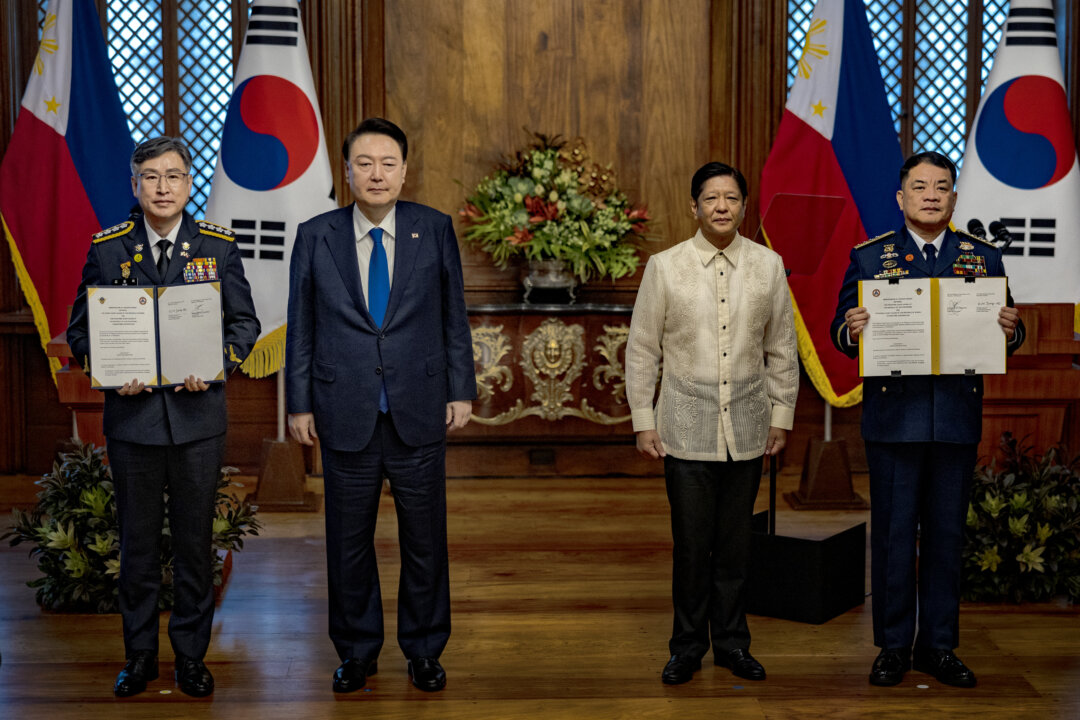The Philippines and South Korea are both treaty allies of the United States, bound by respective mutual defense agreements.
South Korea and the Philippines signed a joint declaration on Monday to form a strategic partnership and expand their cooperation in various areas, including security and defense.
The joint declaration was made during a meeting between Filipino President Ferdinand Marcos Jr. and South Korean President Yoon Suk Yeol, who was on a two-day state visit to the Philippines from Oct. 6 to Oct. 7. Yoon became the first South Korean president to visit the Philippines since 2011.
The two leaders discussed global and regional issues, including the situation in the disputed South China Sea, where communist China has increased its military presence, and the Korean Peninsula, where tensions have been rising due to North Korea’s ongoing missile tests.
During the meeting, Marcos emphasized the importance of strengthening the cooperation between their countries in the face of an “increasingly complex geopolitical and economic environment.”
“Our decades of cordial relations have developed into a comprehensive partnership that spans political, defense, economic, socio-cultural, maritime and many other fields, across various levels of engagement,” he said, according to a statement released by his office.
The two countries agreed to boost maritime cooperation and maintain “close engagement” between their military and defense organizations to bolster their readiness to respond to security threats.
South Korea will also assist in modernizing the Philippine armed forces, according to the joint declaration issued by Yoon’s office.
They pledged to conduct “mutually beneficial” security and defense engagements and participate in bilateral military exercises, education, and training to address security challenges, according to the declaration.
In the declaration, both countries condemned North Korea’s “unprecedented surge” in ballistic missile launches and called on Pyongyang to comply with its obligations under U.N. Security Council resolutions.
The most recent test was on Sept. 18, when South Korea’s military said it detected multiple short-range ballistic missiles launched from North Korea, though it did not specify where the projectiles landed.
The declaration stated that the two countries opposed the “militarization of reclaimed features, the dangerous use of coast guard and maritime militia vessels, and coercive activities” in the South China Sea.
The meeting also resulted in signing several memorandum of understanding agreements between the two countries, including one focused on expanding cooperation between their coast guards.
Yoon said they shared a common understanding about the importance of upholding peace and stability in the South China Sea, which he described as a “critical sea lane of communications” in the Indo-Pacific region.
“In this regard, our two countries will continue to work together in order to establish a rules-based maritime order and for the freedom of navigation and overflight pursuant to the principles of the international law in the South China Sea,” he said in a statement.
The Philippines and South Korea are treaty allies of the United States, bound by respective mutual defense agreements. This means the United States is obligated to come to their defense if either of them is under attack.
Beijing has asserted territorial claims over nearly the entire South China Sea, including reefs and islands that overlap with the exclusive economic zones of Vietnam, Malaysia, Brunei, Taiwan, and the Philippines.
An international tribunal in The Hague ruled in favor of the Philippines in legal action taken by the country in 2016, stating that Beijing’s sovereignty claims had no legal basis.
However, the tribunal’s ruling didn’t change the Chinese regime’s behavior, with Chinese vessels repeatedly intruding on the Philippines’s maritime zones.
On Aug. 31, for example, the Philippines said a Chinese coast guard vessel “intentionally” rammed and collided with its coast guard vessel stationed at Escoda Shoal in the South China Sea, causing damage to the Philippine vessel.

